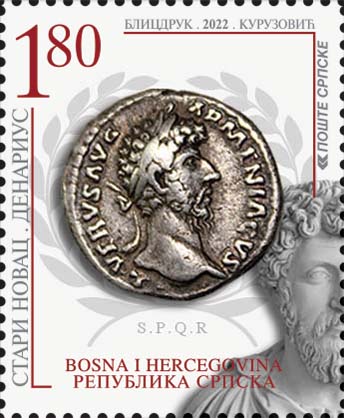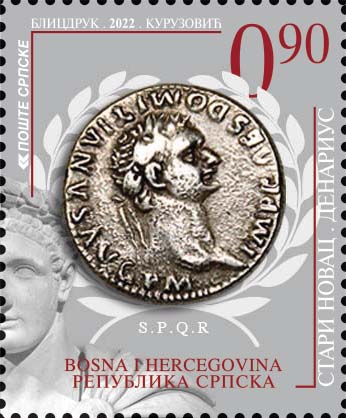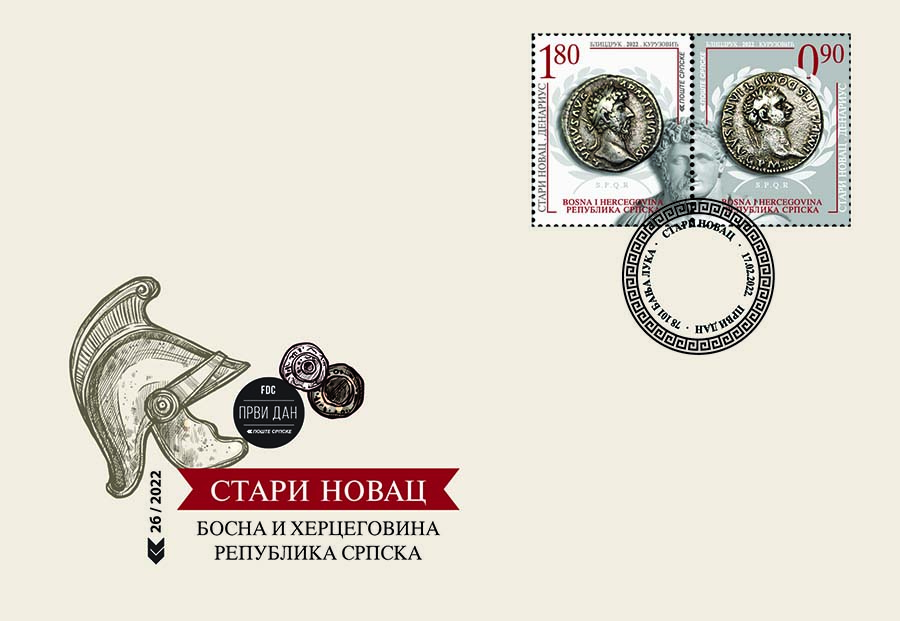Old coins
Title:Old coins
Date of Issue: 24.02.2022.
Author: Tanja Kuruzovic
Type edition: commemorative
Printing techniques: multicolour offset
Sheet: 4х2
Paper: muflep 100g
Printing House: Blicdruk, Sarajevo
 Motive: Trajan Marcus
Motive: Trajan Marcus
Catalogue no.:892
Perforation: 13 3/4
Face value: 1.80 BAM
Quantity: 15 000
 Motive: parts of the bicycle
Motive: parts of the bicycle
Catalogue no.:893
Perforation: 13 3/4
Face value: 0.90 BAM
Quantity: 15 000
 Motive: Lucius Verus
Motive: Lucius Verus
Catalogue no.: 894
Perforation: 13 3/4
Face value: 1.80 BAM
Quantity: 15 000
 Motive: Domician
Motive: Domician
Catalogue no.: 895
Perforation: 13 3/4
Face value: 0.90 BAM
Quantity: 15 000

The issuance of money in Rome was, mostly, reserved for emperors and their families, although it could be issued by others who could afford it.
The Roman Empire stretched from the Atlantic Ocean in the west to the Dead Sea in the east and the Sahara in the south, to the Danube in the north, and thus in this area.
The method of finding Roman (and other types) of money can be divided into three types: findings during archaeological research of the terrain, random (group) findings and individual random findings. All these coins, represented by postage stamps, were found as accidental individual findings along the Sava riverbed in Gradiska. The Sava was one of the most important roads for the transport of goods, and Gradiska also had a port at that time next to the settlement of Servitium (on the site of today's town of Gradiska), which was an important crossroads. All this gives us a predisposition for rich and diverse archeological findings from that period.
With this issue, we have presented four coins in their actual size, 19 mm in diameter, as follows:
Coin with one of the greatest Roman rulers: Traianus - Marcus Ulpius Nerva Traianus. He ruled from 98 to 117. He was a Roman emperor, heir to Nervin and a member of the Antonine dynasty.
A coin with the image of Julie Augusta (193-217), the wife of Emperor Septimius Severus, the mother of Emperor Caracalla of the North Dynasty.
Coin with the Roman emperor - Lucius Verus (161-169). He belonged to the Antonine dynasty. Adopted son of Antonius Pius, who inherited the throne. The son of Antonius Pisa, Marcus Aurelius, inherited the throne.
Coin with the figure of Domitian (Titus Flavius Domitianus) who ruled from 81 to 96. He was the son of Vespasian and the younger brother of Titus, as well as the last emperor in the Flavian dynasty.
Author: Tanja Kuruzovic
Publisher: Poste Srpske a.d. Banjaluka
Cooperation: Association of Collectors and History Lovers "Denarius", Gradiska; Mesic Alen, Miroslav Kecman, Albin Zidar

In the system of ancient Roman currencies, the denarius (lat. Denarius, plural denarii) was a small silver coin first smithed in 211 BC.
At the beginning of the 1st century, one Denarius was the daily wage of one worker. It was the most common coin in circulation, but it devalued over time until it was replaced by the Antoninian.
Denarius was the original coin of 10 aces and in the time of the empire was never numbered. This coin was the silver currency in the Roman Empire until 248 BC.
It is interesting how the Latin name denarius survived for centuries and was adopted in various forms by other peoples: in France denier is the name for a coin, the dinar is often the name of the national currency among Arabs, as in the former Yugoslavia and present Serbia; Macedonians have denar; with the Slovenes a denar, and with the Italians a denaro is money, with the Spanish it is a dinero, etc. Of course, the legacy we inherit today from Ancient Rome is much broader and richer than some words are; there are also letters, architecture, art, history, literature, law, politics ...
Author: Tanja Kuruzovic
Publisher: Poste Srpske a.d. Banjaluka
Cooperation: Association of Collectors and History Lovers "Denarius", Gradiska; Mesic Alen, Miroslav Kecman, Albin Zidar
 1371
1371  kontakt@postesrpske.com
kontakt@postesrpske.com


